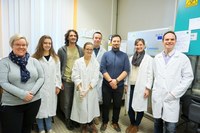Portrait of the month: Benoît Muylkens' research team
"Exploring molecular mysteries of infectious diseases at the human-animal interface"
From left to right: Laëtitia Wiggers (technician), Gabrielle Trozzi (Master BBMC), Damien Coupeau (post-doc), Céline Istasse (Bac Biomed), Alexis Chasseur (Master BBMC), Srđan Pejaković (PhD student), Astrid Petit (PhD student) and Benoît Muylkens (Principal Investigator)
Professor at the Veterinary Medicine Department of the UNamur, Benoît MUYLKENS is a recognized expert in the field of molecular virology. His research interests include the genetic regulation of the Herpesvirus life cycle, the epidemiology and control of emerging viral diseases of livestock, the mechanisms of viral diversification through mutation and reassortment in ruminant Bunyaviruses, as well as antimicrobial drug resistance at the human-animal interface.
Benoît Muylkens' research team is part of the Integrated Veterinary Research Unit (URVI) and the Namur Research Pole in Infectiology (NaRePI).
Four projects are currently ongoing in his lab:
Deciphering the genetic regulation of viral and host cellular genes during infection with the oncogenic Marek's disease virus
Gallid herpesvirus 2 (GaHV-2) is an oncogenic α-herpesvirus that induces Marek's disease, a lymphoma of chickens. The GaHV-2 genome integrates into the host genome and, by modulating expression of viral and cellular genes, induces transformation of latently infected cells. The research of Srđan PEJAKOVIC, a fourth year PhD student, addresses the epigenetic regulation of the viral telomerase RNA subunit promoter over-expressed during Marek’s disease virus induced oncogenesis. Astrid PETIT, a new PhD student who recently joined the team, will focus on several host genes encoding microRNAs, which undergo epigenetic silencing during cancer progression and thus likely play a role as tumor suppressors. Her goal will be to restore chicken miRNAs expression in this unique animal model of viral oncogenesis and to demonstrate the anti-tumoral potential of host miRNAs.
Unravelling reassortment dynamics among Simbuviruses related to Schmallenberg virus
The emerging Schmallenberg virus likely originated from a reassortment process involving ruminant Simbu serogroup Bunyaviruses related to the Shamonda virus (SHAV) and the Sathuperi virus (SATV) species. The work of post-doc researcher Damien COUPEAU aims to evaluate in vitro the reassortment and recombination potential of viruses related to SHAV and SATV, previously shown to spread simultaneously in animal populations of the Sub-Saharan region. An article describing the results from his study has just been accepted for publication in "Emerging Microbes and Infections", a high impact journal in microbiology.
Investigating the prevalence and resistance mechanisms of colistin-resistant E. coli (COLREC) at the human-livestock interface
Started early 2019, this one-year project funded by NARILIS is tackling the issue of antimicrobial resistance. The work of Dr. Wiebke JANSEN, post-doc researcher, focuses on the prevalence of COLREC strains in cattle, which are the main reservoir of E. Coli. Thanks to a partnership with the National Reference Center of Antibiotic Resistant Gram Negative Bacilli of the CHU UCL Namur (Prof. Youri Glupczynski, Prof. Te-Din Daniel Huang, Dr. Pierre Bogaerts), these bovine strains will be compared to human strains using next generation sequencing. The spatial distribution of farms, abattoirs and human cases will be studied in collaboration with the UNamur Geography Department (Prof. Catherine Linard).
Contact: benoit.muylkens@unamur.be
 NAmur Research Institute for LIfe Sciences
NAmur Research Institute for LIfe Sciences


